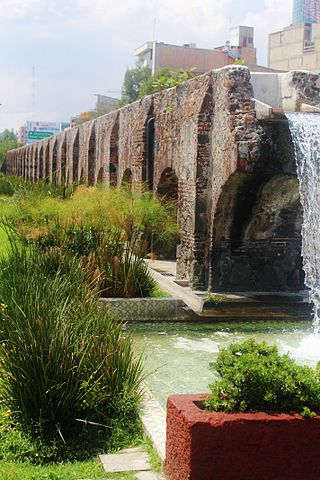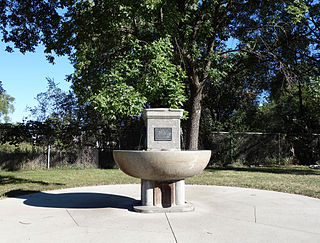
A drinking fountain, also called a water fountain or water bubbler, is a fountain designed to provide drinking water. It consists of a basin with either continuously running water or a tap. The drinker bends down to the stream of water and swallows water directly from the stream. Modern indoor drinking fountains may incorporate filters to remove impurities from the water and chillers to lower its temperature. Drinking fountains are usually found in public places, like schools, rest areas, libraries, and grocery stores.

The Tyler Davidson Fountain or The Genius of Water is a statue and fountain located in Cincinnati, Ohio. It is regarded as the city's symbol and one of the area's most-visited attractions. It was dedicated in 1871 and is the centerpiece of Fountain Square, a hardscape plaza at the corner of 5th and Vine Streets in the downtown area. It is surrounded by stores, hotels, restaurants and offices. Originally, and for more than 130 years, it was located in the center of 5th Street, immediately west of Walnut Street. In 2006, renovations were undertaken to Fountain Square and the Tyler Davidson Fountain was temporarily removed. When reinstalled it was relocated to a much wider space near the north end of the reconfigured square, closer to the Fifth Third Bank Building and away from street traffic. The fountain is turned off for the winter months and turned on again in time for the first home game of Major League Baseball's Cincinnati Reds.

The Metropolitan Drinking Fountain and Cattle Trough Association is an association that was set up in London by Samuel Gurney, a member of Parliament and philanthropist, and Edward Thomas Wakefield, a barrister, in 1859 to provide free drinking water.
The Bright Promises Foundation is a nonprofit organization providing services to disadvantaged children in Illinois

The Burnside Fountain is a non-functioning drinking fountain at the southeast corner of Worcester Common in Worcester, Massachusetts. It consists of two parts, a pink granite basin, and a bronze statue of a young boy riding a sea turtle. The basin was designed by architect Henry Bacon, who later designed the Lincoln Memorial in Washington, D.C., and the figure was created by sculptor Charles Y. Harvey. Harvey died by suicide before finishing the sculpture, and Sherry Fry completed the bronze. The Burnside Fountain was commissioned in 1905 by the city of Worcester after Harriet F. Burnside bequeathed US $5,000 to create a fountain to provide fresh water for people, horses and dogs, in the memory of her father, a prominent lawyer. The fountain was installed in 1912 in Central Square, then moved in 1969 to its current location on Worcester Common. In 1970 the statue was stolen, and was re-installed two years later. An attempted theft occurred in 2004.

A watering trough is a man-made or natural receptacle intended to provide drinking water to animals, livestock on farms or ranches or wild animals.

The Chapultepec aqueduct was built to provide potable water to Tenochtitlan, now known as Mexico City. This fresh water was transported from the Chapultepec springs. Two aqueducts following the same route from the springs were built by the Aztecs during the 15th century, the first destroyed by flooding and the second by the Spanish. After the Spanish conquest a colonial aqueduct was built, the ruins of which are located near Metro Sevilla.
Henry Bergh is a statue by American artist James H. Mahoney located at the Wisconsin Humane Society in Milwaukee, Wisconsin, United States. The bronze statue portrays Henry Bergh, the father of the humane movement in the United States, holding a cane in his proper right hand and petting a dog with a bandaged paw with his proper left hand. It was created in 1891 and stands 9 feet high.

The R. D. Whitehead Monument is a public artwork by Norwegian born American artist Sigvald Asbjornsen located on the south side of Milwaukee, Wisconsin, United States. The artwork consists of a bronze-relief plaque depicting a dog and horse, set on a granite pillar, which is in turn part of a fountain.
The Lörrach Sculpture Path is a Sculpture trail of 23 works and fountains through the southern German city of Lörrach.

The Admission Day Monument is an 1897 sculpture by Douglas Tilden, located at the intersection of Market Street and Montgomery Street in San Francisco, California, United States. It commemorates California Admission Day, the date on which the state became part of the Union, following the Mexican-American war of 1848.

The Thomas Temple Fountain was a cast-iron and granite drinking fountain for "man and beast" in Fredericton, New Brunswick, Canada. It no longer functions as a fountain but remains in place as a work of public art. It is located at the north end of Queen Street, just west of the Beaverbrook Art Gallery. The Temple Fountain was added to Fredericton's Local Historic Places Register in June 2011.
This is a history and list of drinking fountains in the United States. A drinking fountain, also called a water fountain or bubbler, is a fountain designed to provide drinking water. It consists of a basin with either continuously running water or a tap. The drinker bends down to the stream of water and swallows water directly from the stream. Drinking water fountains are most commonly found in heavy usage areas like public amenities, schools, airports, and museums.

The Military Working Dog Teams National Monument is a monument to military working dogs located at Joint Base San Antonio (JBSA)-Lackland in San Antonio, Texas. The monument represents handlers, dogs, and veterinary support, from all military service branches that have made up the Military Working Dog program since World War II. The monument grounds include a 3,000 square feet granite plaza, granite pedestals, granite history wall, granite benches and water fountain. The granite pedestals have large bronze statues of dogs and handlers. The monument was dedicated on October 28, 2013.

Dog Bowl is an outdoor 2002 sculpture by dog photographer William Wegman, located in the North Park Blocks in Portland, Oregon, United States.

The Southeast Water Trough is an historic structure located in Des Moines, Iowa, United States. It is one of the last of 15 National Humane Alliance fountains that were placed around the city by the Iowa Humane Alliance. They were also named Ensign fountains after the founder of the National Humane Alliance, Hermon Lee Ensign. This was one of two placed in Des Moines in 1906.

Rondebosch Fountain is an ornamental Victorian drinking trough for horses, standing on a traffic island on the intersection between Belmont Road and Main Road in the centre of Rondebosch in Cape Town, South Africa. It was declared a National Monument on 10 April 1964.
The Prince of Wales Obelisk in Port Elizabeth, South Africa, was erected in honor of the marriage of Prince Albert of Wales, later King Edward VII of the United Kingdom, and Alexandra of Denmark but not originally intended for them. It is thus one of the only "second-hand" royal monuments in the world. It was originally purchased for the grave of George Kemp. It was later moved in front of the Bayworld museum complex. The monument is a simple obelisk carved out of an igneous rock similar to granite.

William Lisle Blenkinsopp Coulson was an English army officer and campaigner for animal welfare. He was a notable supporter of the Humanitarian League. After his death, he was memorialised by a statue in Newcastle upon Tyne.

Public drinking fountains in Philadelphia, Pennsylvania, United States, have been built and used since the 19th century. Various reform-minded organizations in the city supported public drinking fountains as street furniture for different but overlapping reasons. One was the general promotion of public health, in an era of poor water and typhoid fever. Leaders of the temperance movement such as the Woman's Christian Temperance Union saw free, clean water as a crucial alternative to beer. Emerging animal welfare organizations, notably the Society for the Prevention of Cruelty to Animals, wanted to provide water to the dogs and working horses of the city on humanitarian grounds, which is why Philadelphia's drinking fountains of the era often include curb-level troughs that animals could reach.

















